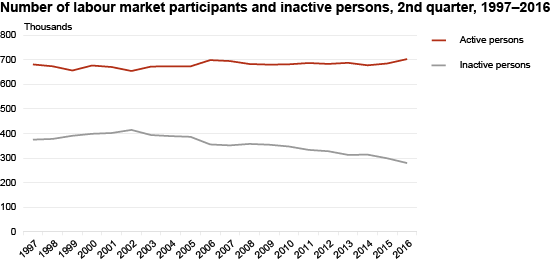The level of activity of working-age population in the labour market rose
The unemployment rate remained on the same level as in the 2nd quarter of 2015. There were no significant changes in the number of unemployed persons either: while in the 2nd quarter of 2015 the number of unemployed persons was established at 44,000, then a year later at 45,000.
While the number of working-age persons (15–74-year-olds) continued its slow decline, then the level of activity in the labour market continued heading in the opposite direction. In the 2nd quarter of 2016, both the employment rate (66.9%) and the labour force participation rate (71.5%) were the highest in the last 20 years. The number of persons active in the labour market (the sum of the employed and unemployed) exceeded 700,000 for the first time and was established at 702,000. In a situation where the working-age population is declining, the number of labour market participants can increase only if more inactive persons enter the labour market. Compared to the 2nd quarter of 2015, the number of inactive persons decreased by nearly 20,000 and was approximately 280,000 in the 2nd quarter of 2016.
The elderly (50–74-year-olds) contributed the most to the increase in the employment rate. While in the 2nd quarter of 2015 the employment rate of the elderly was 54%, in the 2nd quarter of 2016 it was 57.9%. The employment rate rose both for males and females, but in all age groups females accounted for a bigger share in the rise. The employment rate increased both among Estonians and non-Estonians. The unemployment cleavage between Estonians and non-Estonians narrowed because the unemployment rate of non-Estonians dropped and that of Estonians grew slightly. In the 2nd quarter of 2016, the unemployment rate of Estonians was 5.8% and that of non-Estonians was 8%. What could have influenced the improvement of employment figures compared to those recorded in the 2nd quarter of 2015 is the rise in the pensionable age of females by half a year, the Work Ability Reform and – despite its moderate pace – economic growth as well.
The unemployment rate is the share of the unemployed in the labour force (the sum of employed and unemployed persons). The employment rate is the share of the employed in the working-age population (aged 15–74). The labour force participation rate shows the share of the labour force in the population aged 15–74. The estimates are based on the data of the Labour Force Survey.
Statistics Estonia has been conducting the Labour Force Survey since 1995 and every quarter 5,000 persons participate in the survey. The Labour Force Survey is carried out by statistical organisations in all the European Union Member States on the basis of a harmonised methodology.
